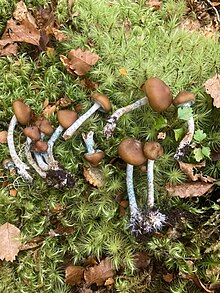Psilocybe makarorae
| Psilocybe makarorae | |
|---|---|

| |
| Scientific classification | |
| Domain: | Eukaryota |
| Kingdom: | Fungi |
| Division: | Basidiomycota |
| Class: | Agaricomycetes |
| Order: | Agaricales |
| Family: | Hymenogastraceae |
| Genus: | Psilocybe |
| Species: | P. makarorae
|
| Binomial name | |
| Psilocybe makarorae P.R.Johnst. & P.K.Buchanan (1995)
| |
Psilocybe makarorae is a species of
Taxonomy
The species was first mentioned in the literature in 1981, when Pierre Margot and
The
Description
The cap is initially conical to bell shaped, but as the mushroom grows, it expands to become convex with a prominent umbo, and attains a diameter of 15–55 mm (0.6–2.2 in). The cap surface is dry to slightly tacky. Its colour is yellow-brown to orange-brown, often paler towards the margin, which has fine striations corresponding to the gills on the underside. The flesh is white. Gills have an adnexed attachment to the stem, and are pale greyish brown. The whitish stem is 30–60 millimetres (1.2–2.4 in) long by 2–4 mm wide. It is cylindrical, with a surface of pressed silky fibrils. The base of the stem is often brownish, with white rhizoids present. The veil of young fruit bodies is cortinate—resembling the cobweb-like partial veil found in Cortinarius species. As the mushroom grows, its remnants often remain visible on the stem, but it never forms a complete ring. Both the cap and the stem stain greenish-blue when damaged.[2]
The
The cheilocystidia (
P. makarorae contains the psychedelic compounds psilocybin and psilocin. Although the potency is not known definitely, Stamets suggests that, based on the degree of the bluing reaction, they are "probably moderately potent".[3]
Similar species
Psilocybe makarorae is related to Psilocybe weraroa and Psilocybe subaeruginosa, though not as closely as they are to each other.
Habitat and distribution
Psilocybe makarorae is known only from New Zealand.
See also
- Legal status of psilocybin mushrooms
- List of psilocybin mushrooms
- List of Psilocybe species
References
- .
- ^ .
- ^ a b Stamets (1996), pp. 126–7.
- ^ Guzmán G, Allen JW, Gartz J (2000). "A worldwide geographical distribution of the neurotropic fungi, an analysis and discussion" (PDF). Annali del Museo Civico di Rovereto: Sezione Archeologia, Storia, Scienze Naturali. 14: 189–280.
Cited texts
- Stamets P. (1996). Psilocybin Mushrooms of the World: An Identification Guide. Berkeley, California: Ten Speed Press. ISBN 978-0-89815-839-7.
External links
- Psilocybe makarorae in Index Fungorum
- Landcare Research Manaaki Whenua Images and text of original description
